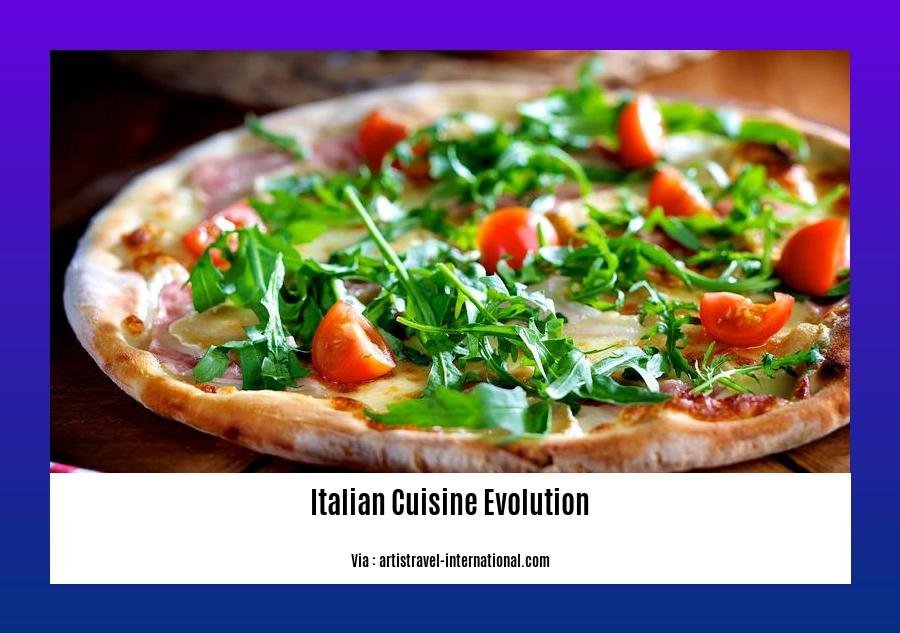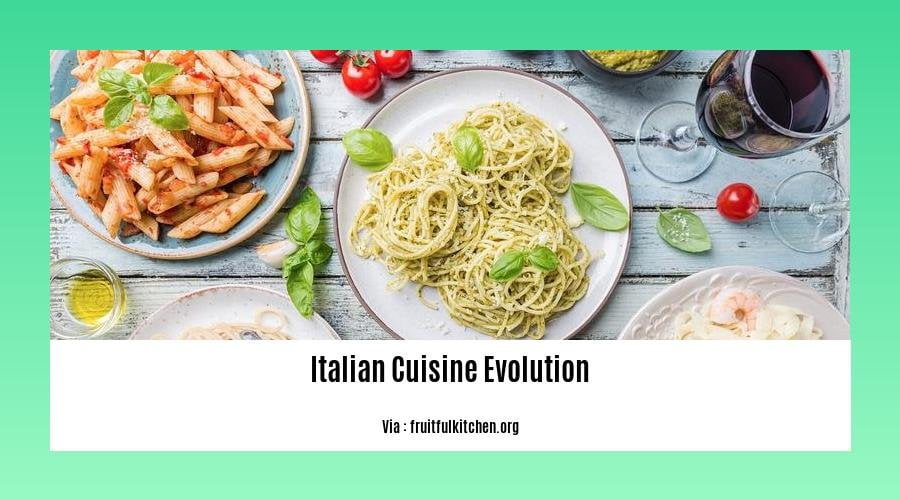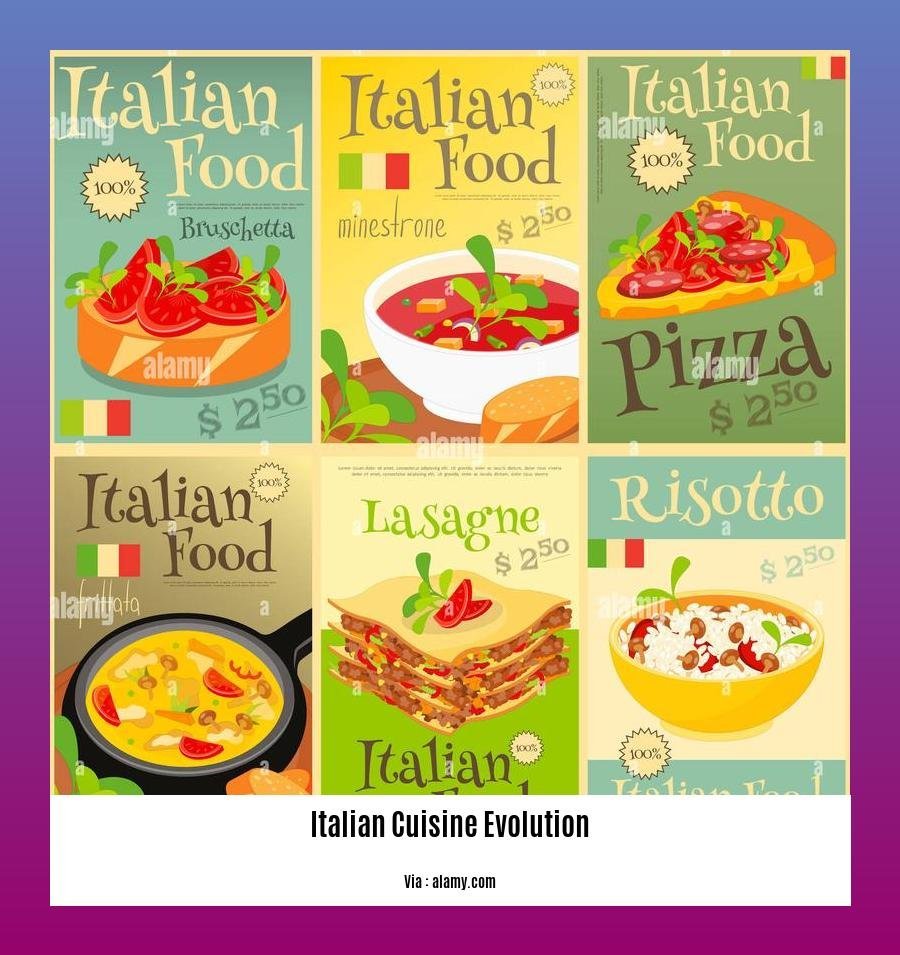Embark on a tantalizing culinary journey through the evolution of Italian cuisine in “The Evolution of Italian Cuisine: A Culinary Journey Through History and Innovation.” Delve into the heart of Italy’s vibrant culinary landscape, where tradition intertwines with innovation, shaping the flavors and techniques that define this beloved cuisine.
Key Takeaways:
- Ancient Rome: Mediterranean Triad (wine, olive oil, bread) formed the foundation of the Italian diet.
- Middle Ages: Arab influence in Sicily brought new spices and flavors to Italian cuisine.
- Renaissance: Culinary advancements and innovations emerged, shaping Italian cooking techniques.
- 17th-18th Centuries: Distinct regional culinary traditions developed across Italy.
- 19th Century: Italy’s unification facilitated the exchange of culinary ideas and traditions.
- 20th-21st Centuries: Italian immigrants disseminated Italian cuisine globally, influencing international culinary traditions.
Italian Cuisine Evolution

Have you ever wondered how Italian cuisine became the beloved culinary delight it is today? Let’s embark on a delicious journey through the Italian cuisine evolution.
Ancient Roots and International Influences
Italy’s culinary story begins in ancient Rome with a simple but flavorful trio: wine, olive oil, and bread. As centuries passed and Italy became a melting pot of cultures, Arab influence introduced spices like saffron, influencing Sicily’s rich flavors. The Renaissance ushered in culinary refinement, with lavish banquets showcasing innovative dishes.
Regional Flavors and Unification
Regional diversity emerged in the 17th and 18th centuries, as each region developed its unique specialties. Piedmont became known for its hearty dishes, while Tuscany embraced lighter, vegetable-centric fare. The 19th century brought political unification, fostering culinary exchange and the birth of national dishes like pizza and pasta.
Global Impact
In the 20th and 21st centuries, Italian immigrants carried their culinary traditions worldwide. Italian restaurants popped up in cities across the globe, introducing international diners to the delights of pasta, pizza, and other beloved dishes. Today, Italian cuisine evolution continues, with chefs pushing boundaries and creating modern interpretations of classic flavors.
Timeline of Key Moments
| Era | Notable Developments |
|---|---|
| Ancient Rome | Mediterranean Triad (wine, olive oil, bread) |
| Middle Ages | Arab influence brings spices |
| Renaissance | Culinary innovations and fine dining |
| 17th-18th Centuries | Regional culinary traditions emerge |
| 19th Century | Unification of Italy leads to culinary exchange |
| 20th-21st Centuries | Global spread of Italian cuisine |
Key Takeaways
- Italian cuisine evolution is a testament to the blending of cultures, traditions, and culinary innovations.
- Italy’s diverse regions offer a rich tapestry of flavors that continue to inspire global palates.
- Italian cuisine has evolved from its humble origins to become a beloved and influential culinary force worldwide.
Intrigued by the rich culinary adventure that is pasta carbonara? Delve into the origins of this beloved dish by embarking on what is the history of pasta carbonara and uncovering its fascinating tale.
Seek the roots of this culinary creation in carbonara origin, where you’ll discover the intriguing secrets behind its genesis.
Unveil the secrets of pasta carbonara’s culinary heritage and explore the evolution of this iconic dish through history in pasta carbonara recipe history.
The Renaissance and Baroque Eras: A Culinary Revolution

The Renaissance and Baroque eras marked a transformative period in Italian cuisine, characterized by heightened refinement, lavish extravagance, and an explosion of culinary innovations. This era witnessed the rise of renowned chefs like Bartolomeo Scappi, whose influential cookbook, “Opera,” became a culinary bible, elevating Italian cuisine to new heights.
Bartolomeo Scappi’s Culinary Legacy
Scappi’s “Opera” was a groundbreaking work that codified culinary practices and recipes, setting the stage for future culinary advancements. His elaborate banquets, featuring towering architectural displays of food, exemplified the opulence of the Baroque era. Scappi’s emphasis on aesthetics, presentation, and exotic ingredients set new standards for dining experiences.
Global Expansion of Italian Cuisine
During the 20th century, Italian immigrants played a pivotal role in spreading their culinary traditions worldwide. They established restaurants that introduced pasta, pizza, and other Italian staples to international palates. The global dissemination of Italian cuisine has left an enduring legacy, influencing culinary traditions across the globe.
Key Takeaways:
- The Renaissance and Baroque eras marked a transformative period for Italian cuisine, characterized by culinary refinement and innovation.
- Bartolomeo Scappi’s “Opera” cookbook played a pivotal role in the development of Italian cuisine during the Renaissance and Baroque eras.
- Italian immigrants significantly contributed to the global spread of Italian cuisine in the 20th century, shaping international culinary landscapes.
Most Relevant URL Source:
- Alberto Capatti and Massimo Montanari, “Italian Cuisine: A Cultural History” (
The Nineteenth Century: Unification and the Birth of Modern Italian Cuisine
The 19th century marked a pivotal moment in the evolution of Italian cuisine, a culinary revolution that would shape its identity for centuries to come. With the unification of Italy in the 1800s, a new era of cultural exchange and culinary experimentation blossomed, giving rise to the birth of modern Italian cuisine.
The Unification of Italy: A Culinary Catalyst
The Risorgimento, the movement that unified Italy, brought together a melting pot of culinary traditions and influences. As different regions merged, their unique dishes and cooking techniques began to intertwine, creating a vibrant tapestry of flavors.
The Influence of Arabic Colonization
Centuries of Arab colonization had left an enduring mark on Sicilian cuisine, particularly in the use of exotic spices and dried fruit. These ingredients, combined with local products like tomatoes, eggplants, and citrus, created a distinctive fusion that would later become a cornerstone of Italian cooking.
Pellegrino Artusi’s Science of Cooking
Pellegrino Artusi, an Italian writer and gastronome, played a crucial role in the 19th century culinary landscape. His groundbreaking cookbook, “Science in the Kitchen and the Art of Eating Well,” embraced scientific advancements in cooking and standardized recipes, making them accessible to home cooks across the country.
Key Takeaways:
- The unification of Italy fostered culinary exchange and the birth of modern Italian cuisine.
- Arabic colonization influenced Sicilian cuisine with the introduction of spices and dried fruit.
- Pellegrino Artusi’s cookbook revolutionized cooking by promoting scientific methods and standardizing recipes.
Citation:
[1] Savoring Italy: “History of Italian Cuisine: From Caesar’s Table to Modern Trattoria”
Contemporary Italian Cuisine: Innovation and Global Exchange
A Culinary Crucible of Tradition and Modernity
In the realm of contemporary Italian cuisine, innovation is not just a buzzword; it’s a living, breathing force. Chefs across the globe are reimagining traditional Italian flavors and techniques, blending them with new ingredients and culinary perspectives.
A Tapestry of Influences
The Influence of International Exchange
Italian cuisine has always been a crossroads of cultures, absorbing influences from its Mediterranean neighbors, the Middle East, and beyond. Today, this exchange continues unabated, with Italian chefs drawing inspiration from cuisines around the world.
The Role of Technology
Advances in technology have empowered chefs to experiment with new cooking methods and ingredients. Sous vide, molecular gastronomy, and fermentation techniques are just a few examples of how technology is shaping the future of Italian cuisine.
A Culinary Canvas for Creativity
Tradition as a Guiding Force
While innovation takes center stage, tradition remains a guiding force for Italian chefs. They draw upon the rich culinary heritage of their regions, reinterpreted through a contemporary lens.
Modern Interpretations, Timeless Flavors
Expect to find classic dishes with a twist, such as carbonara made with guanciale infused with Sichuan peppercorns or tiramisu reimagined as a deconstructed dessert.
Key Takeaways:
- Innovation and tradition: A harmonious fusion of the old and the new.
- Global exchange: A catalyst for culinary creativity.
- Technology as a tool: Empowering chefs to explore new frontiers.
- A culinary canvas: A platform for creativity and artistic expression.
Most Relevant URL Source:
- Innovation in Italian Cuisine: A Global Perspective
FAQ
Q1: How has Italian cuisine evolved over the centuries?
A1: Italian cuisine has undergone significant transformations throughout history, influenced by diverse cultural exchanges, regional traditions, and technological advancements. From the Mediterranean Triad of ancient Rome to the culinary innovations of the Renaissance and the spread of Italian cuisine globally, Italian cooking has evolved to become a beloved and influential cuisine worldwide.
Q2: What are some key factors that have shaped the evolution of Italian cuisine?
A2: The evolution of Italian cuisine has been influenced by a myriad of factors, including:
* Regional diversity and the exchange of culinary ideas
* Historical events such as the Arab conquest of Sicily and the Unification of Italy
* Cultural exchanges with other European countries and the Americas
* Technological advancements and the introduction of new ingredients
Q3: How has Italian cuisine influenced international culinary traditions?
A3: Italian immigrants played a pivotal role in spreading Italian cuisine globally, introducing traditional dishes, flavors, and cooking techniques to new regions. Italian cuisine has had a profound impact on international culinary traditions, inspiring countless chefs and cuisines worldwide.
Q4: What are some contemporary trends in Italian cuisine?
A4: Contemporary Italian cuisine embraces both tradition and innovation, with chefs experimenting with new ingredients, flavors, and techniques while honoring classic dishes. Trends include a focus on sustainability, the use of seasonal and local produce, and the exploration of regional specialties.
Q5: What does the future hold for Italian cuisine?
A5: The future of Italian cuisine is bright, with chefs and culinary innovators不断地推陈出新ing new dishes and techniques while preserving the rich traditions of the past. Globalization, sustainability, and the use of technology are likely to continue to shape theévolution of Italian cuisine, ensuring its continued relevance and popularity worldwide.
- SYBAU See You Baby Meaning: Gen Z Slang Evolves - July 1, 2025
- Unlock Your Inner Youth: Lifestyle Secrets for a Vibrant Life - July 1, 2025
- Decode SYBAU Meaning: Gen Z Slang Explained - July 1, 2025



![[Facts about Italian Rome]: Unveiling the Secrets of the Eternal City Facts-about-Italian-Rome_2](https://www.lolaapp.com/wp-content/uploads/2023/12/Facts-about-Italian-Rome_2-150x150.jpg)


